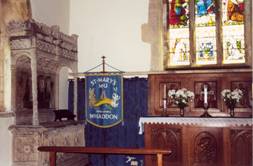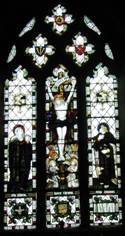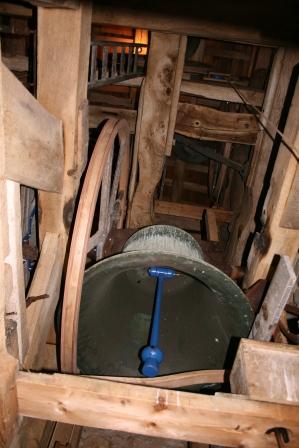Whaddon is an old Celtic word meaning “Wheat Hill”. Whaddon stands 429 feet above sea level and was once surrounded by dense forest, the Whaddon Chase, which gives its name to the local Hunt. There is evidence that Whaddon was inhabited in pre-historic times – a flint skin-scraper was uncovered near the church.
Ancient British and Roman coins have also been found, and the site of a Roman camp is nearby.
The Chancel and Nave.

The original chancel and nave were completed early in the 12th century. The nave pillars still remain.
One capital decoration shows the curious design of two peacocks quarrelling over a piece of bread. A duplicate of this design has been found in a church in Normandy – it is possible that the same Norman workman carved them both!.
The Lady Chapel

The Lady Chapel contains two Tudor tombs. One tomb is for a “Serjant-at-law” and his family, while the other is the tomb of a Lord Deputy of Ireland for Queen Elizabeth I who was one of the Commissioners responsible for trying Mary Queen of Scots.
The Tudor Bishop of Ely was also born at Whaddon.
Victorian Stained Glass Windows

We are particularly proud of our stained glass windows at Whaddon. The well known Victorian artist, Kemp, made the east window. His signature peacock feathers can be seen in the angels’ wings. The signed west window is by J. Bell & Son of Bristol. There are fragments of mediaeval stained glass in the east window behind the organ. These were collected in 1889
20th and 21st Century Changes

The stone font was carved in the 13th century, but the wooden cover with its beautiful carved dove is from the 20th century. In the 21st century, we have now re-sited the rear pews, repaired the floor and bought moveable (and more comfortable) chairs to create a flexible open space for community use – e.g. for baptisms round the font, Toddler Group, Christmas services and concerts,
community Coffee Shop, etc. New kneelers have been stitched by local ladies, and plans are underway for a specially designed kneeler for the Lady Chapel altar rail.
We are also improving the heating arrangements so that you can enjoy our ancient building without experiencing 12th century chills!
Bells

The Tower contains a ring of 6 bells together with a small Sanctus bell. The ring, though not the Sanctus, was recast in 1927 by Gillett and Johnson though they were probably originally Chandler bells – the treble, fourth, fifth and tenor being by Anthony Chandler, 1671, the Sanctus by George Chandler, 1682 and the second by Richard Chandler, 1713. These would have been cast in the foundry at Drayton Parslow. The third was by Emerton of Wootton, 1780. However, none of the bells are listed in the ‘Schedule of Bells for Preservation’ held by Oxford Diocese.
All the bells have modern flat crowns and all hang in their original un-turned position. The clock hammer is fitted to the Tenor bell. After recasting in 1927, the bells were rehung on their original oak beams. The bell frame is a two tier bell frame estimated to be of 18th Century origin. The bottom frame supports the Tenor and Fifth side-by-side swinging East West and the frame itself is supported on 3 Oak beams also spanning East West. The top frame houses the remaining bells with the Fourth, Treble and Second in order from South to North swinging side-by-side East West on the West side of the tower.
The Third swings North South at the East end of the Treble and Second pits. This frame is supported by two further Oak beams spanning the Tower North South. The ringing fittings are also by Gillet and Johnson of 1927 origin but they have recently (2006) been overhauled by Whites of Appleton, Whaddon’s long time bell hangers. This work was supported by both The Sharpe Trust and The Oxford Diocesan Bell Fund as well as many villagers. The Tower Captain and team of ringers are most grateful for their support.
The bells are currently rung for all the major Christian Festivals as well as two Sundays a month and for local weddings. Practices are held on Tuesday evenings and the team are happy to include volunteers of any ability. Guest teams are welcome.
(Bell Report by David Spencer)
